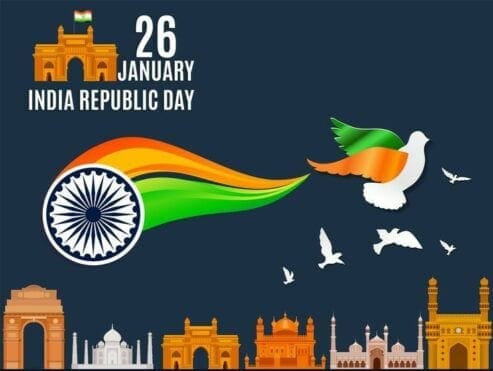
On 26th January 2021, India celebrated its 72nd annual Republic Day amidst the pandemic – an unasked “guest” in the country for almost a year now. Surprisingly, the annual celebration under the shadow of Covid-19 became an invisible concern when the political and communal tensions hijacked the national capital soon after the sacred ceremony at Rajpath came to an end. As the media tradition would have it, the Republic Day parade is broadcasted on television in the second half of the day for the people who missed out on the morning ceremony. Unfortunately, the 72nd Republic Day turned out to be an exception.
Why is Republic Day celebrated?
Independent India, each year, on 26th January, celebrates Republic Day to honour the day on which the Indian Constitution was brought to force in 1950. The History books that speak of India’s dismal state under the ‘British Raaj’ for more than two centuries carry the struggle of every freedom fighter who fought till their last breath, hoping to free this country from the demonic claws of the East India Company. The Indian Independence Act 1947 did release the ‘golden bird’ trapped behind bars for more than 200 years; however, independence in its true sense and spirit was only gained after adopting the Constitution by the Indian Constituent Assembly. Seventy-two years ago, it was on this auspicious day that Dr. Bhimrao Ramji Ambedkar’s (Father of the Indian Constitution) architecture replaced the Government of India Act 1935 as the governing force of our country. India’s transition and unmatched struggle from a British colony to a Republic paves the way for this annual celebration in the tri-coloured land of culture and diversity.
What is Republic Day Ceremony?
Every year, flag hoisting ceremonies and parades are executed by the defence forces in different parts of the country. The national capital certainly is the centre of the Republic Day celebrations and is commemorated via one of the largest and foremost parades presided by the President of India on Rajpath. One of the parade’s cardinal objectives other than showcasing India’s rich cultural diversity is to pay tribute to our martyrs who willingly sacrificed their tomorrow for our today. The ceremony commences after the Indian Prime Minister lays a wreath at the Amar Jawan Jyoti at India Gate in memory of the valorous martyrs, followed by the National Flag’s unfurling on the patriotically melodious tunes of the National Anthem. Shortly after, the magnificent parade begins with gallantry awardees saluting the President of India – an inexplicably proud moment for the ones marching gloriously. The diversity and pride exhibited in the Republic Day parade is an authentic representation of India’s prolific culture and heritage. From the array of the newly added equipment to the military’s arsenal to the vivid tableaux from all the Indian states showcasing their customs and traditions, the splendid Republic Day parade is indeed a delight to one’s eyes.
How was this year’s Republic Day different?
The Republic Day celebrations for long have been apposite to the grand parades, large crowds with hearts swelling up in pride, and the exquisite exhibition of cultures across India’s different states. However, the 72nd annual celebration was an exception as the pandemic had filled the enthusiastic air with disquiet and distress. And the farmers’ protest only acted as icing on the cake of tensions. Not long ago did the world witness the disruption in America for everyone to consume Capitol Hill repeats itself, only worse, at the national capital — New Delhi. This year’s Republic Day was not different solely because of the pandemic and the political strains. Other than the spectators’ limited participation from 1,50,000 to 25,000, the iconic parade witnessed a thread of changes.
India, so far, has received 11 out of 36 Rafale jets procured from France. These Rafale jets, for the first time, were out on display for the common public. The concern of women’s security in India is still subdued under a question mark. However, on the other hand, women like Flight Lieutenant Bhawna Kanth created history by being a part of the Indian Airforce Tableau as a woman fighter pilot for the first time. India is known for its hospitality and “Atithi Devo Bhava,” therefore, it is a tradition to have a foreign dignitary as the chief guest on every Republic Day. The UK Prime Minister, Boris Johnson, was supposed to be the chief guest on the 72nd Republic Day until the new strain of Covid-19 emerged in the United Kingdom, which resulted in India having no chief guest. It was last in the year 1966 that there was no chief guest on 26th January. In 2019, France became the first-ever country to participate in the Republic Day celebrations, followed by UAE in 2020. This year it was Bangladesh that became the third country to take part in the parade. The much controversial case of the Ayodhya Ram Mandir that was finally ended by the Supreme Court’s verdict in 2019 in favour of the temple was also featured in the Uttar Pradesh tableau for the first time. Other than the veteran parade by the ex-servicemen and women, motorcycle stunts’ amusement, which leaves the audience in awe each year, did not occur either.
Hence, the 72nd Republic Day parade turned out to be a very different occasion than all the previous years.
Which tableaux caught the attention?
The prime objective behind the concept of tableaux in the Republic Day parade has always been depicting India’s melting-pot. This year, the Ayodhya themed tableau of Uttar Pradesh triumphed in securing the first position among 32 others. Under the government of Chief Minister Yogi Adityanath, Uttar Pradesh’s state displayed the cultural heritage of the most populated state in India through its tableau. Minister of State (MoS) for Youth Affairs & Sports and MoS, Minority Affairs Kiren Rijiju, was bestowed with the opportunity to give away the prizes to the Republic Day participants. The second best, the tableau of Tripura, which showcased eco-friendly traditions for accomplishing self-reliance in socio-economic parameters, booked its place. Lastly, Uttarakhand’s tableau themed ‘Dev Bhoomi’ – ‘The Land of Gods’ was adjudged the third best. Besides 17 tableaux from states, nine from various ministries, departments, paramilitary forces, and six from the Defence Ministry, the Biotechnology tableau won the top honour. Apart from these tableaux, various other tableaux were accoladed with different titles to celebrate their participation and innovation.
Owing to the pandemic and the hapless series of events in New Delhi on 26th January that tarnished India’s reputation worldwide, the 72nd annual Republic Day was nothing like the celebration in the previous years. Nonetheless, this auspicious day’s pride and prestige that celebrates India’s true independence should never be forgotten.

About the author – Aarushi Verma is a first-year student of the Manipal Institute of Communication.

Be the first to comment